Molecular Dynamics Simulation on Nanoindentation of M50 Bearing Steel
Abstract
:1. Introduction
2. Computational Methods
2.1. Computational Model
2.2. Potential Functions
2.3. Simulation Procedure
2.4. Experimental Verification
3. Results and Discussion
3.1. Verification of Simulation Results
3.2. Influence of Temperature on the Hardness of the Model
4. Conclusions
- (1)
- The molecular dynamics model of M50 bearing steel was established. Firstly, Lammps software was used to establish the Fe matrix model, and then a certain amount of Cr, Mo, and V atoms were added to it in the way of random replacement, and then a certain amount of C atoms was added to it in the way of random insertion so that it could meet the mass fraction requirements of each element in M50 bearing steel;
- (2)
- To verify the correctness of the model, a nanoindentation simulation was carried out. Due to the size effect of nanoindentation, the nanohardness obtained by using diamond indenters with different sizes was different, and the larger the radius of the diamond indenter, the smaller the hardness obtained. Then, the nanohardness data were fitted to predict that when the radius of the indenter was 200 nm, the hardness of the M50 plate measured by the nanoindentation was 9.26 GPa;
- (3)
- Five nanoindentation tests were carried out on M50 bearing steel samples, and the average hardness of the five tests was obtained to be 10.4 GPa. The error was reasonable compared with the simulation results, so the M50 plate model was verified to be correct and can be used for subsequent research;
- (4)
- The mechanical properties at different temperatures of the M50 plate were obtained. The results show that the hardness of the model decreases gradually with the increase in temperature. Furthermore, higher temperature makes plastic deformation more likely to occur.
Author Contributions
Funding
Informed Consent Statement
Data Availability Statement
Acknowledgments
Conflicts of Interest
References
- Jian, G. Research on Contact Fatigue Damage Behavior of M50 Steel for Aircraft Rolling Bearings. Ph. D. Thesis, Harbin Institute of Technology, Harbin, China, 2019. [Google Scholar]
- Chenqing, G. Microstructure, and properties of high temperature carbonitriding of bearing steel for aero-engine. J. Met. Heat Treat. 1998, 1, 27–31. [Google Scholar]
- Wang, F.; Qian, D.; Hua, L.; Lu, X. The effect of prior cold rolling on the carbide dissolution, precipitation and dry wear behaviors of M50 bearing steel. Tribol. Int. 2019, 132, 253–264. [Google Scholar]
- Hager, C.H.; Doll, G.L.; Evans, R.D.; Shiller, P.J. Minimum quantity lubrication of M50/M50 and M50/Si3N4 tribological interfaces. Wear 2011, 271, 1761–1771. [Google Scholar]
- Essa, F.; Zhang, Q.; Huang, X.; Ibrahim, A.M.M.; Ali, M.K.A.; Sharshir, S. Enhancing the tribological and mechanical properties of M50 steel using solid lubricants—A detailed review. Proc. Inst. Mech. Eng. Part J J. Eng. Tribol. 2018, 232, 619–642. [Google Scholar]
- Tong, Y.X.; Wang, L.Q.; Gu, L.; Peng, B. Friction and Wear Behavior of Structural Ceramics Sliding against Bearing Steel under Vacuum Condition. Key Eng. Mater. 2011, 474–476, 973–978. [Google Scholar]
- Zhang, C.; Peng, B.; Wang, L.; Ma, X.; Gu, L. Thermal-induced surface damage of M50 steel at rolling-sliding contacts. Wear 2019, 420–421, 116–122. [Google Scholar]
- Komanduri, R.; Chandrasekaran, N.; Raff, L. MD simulation of indentation and scratching of single crystal aluminum. Wear 2000, 240, 113–143. [Google Scholar]
- Ruestes, C.J.; Alhafez, I.A.; Urbassek, H.M. Atomistic Studies of Nanoindentation—A Review of Recent Advances. Crystals 2017, 7, 293. [Google Scholar]
- Yin, L.; Dai, Y.; Hu, H. Nanoindentation Characterization of Single-Crystal Silicon with Oxide Film. Silicon 2022, 14, 5173–5178. [Google Scholar]
- Ewen, J.P.; Restrepo, S.E.; Morgan, N.; Dini, D. Nonequilibrium molecular dynamics simulations of stearic acid adsorbed on iron surfaces with nanoscale roughness. Tribol. Int. 2017, 107, 264–273. [Google Scholar]
- Albina, J.-M.; Kubo, A.; Shiihara, Y.; Umeno, Y. Coarse-Grained Molecular Dynamics Simulations of Boundary Lubrication on Nanostructured Metal Surfaces. Tribol. Lett. 2020, 68, 49. [Google Scholar] [CrossRef]
- Goel, S.; Joshi, S.S.; Abdelal, G.; Agrawal, A. Molecular dynamics simulation of nanoindentation of Fe3C and Fe4C. Mater. Sci. Eng. A 2014, 597, 331–341. [Google Scholar] [CrossRef]
- Ranjan, P.; Balasubramaniam, R.; Jain, V.K. Investigations into the mechanism of material removal and surface modification at atomic scale on stainless steel using molecular dynamics simulation. Philos. Mag. 2018, 98, 1437–1469. [Google Scholar]
- Luu, H.-T.; Dang, S.-L.; Hoang, T.-V.; Gunkelmann, N. Molecular dynamics simulation of nanoindentation in Al and Fe: On the influence of system characteristics. Appl. Surf. Sci. 2021, 551, 149221. [Google Scholar] [CrossRef]
- AlMotasem, A.T.; Bergström, J.; Gåård, A.; Krakhmalev, P.; Holleboom, L.J. Atomistic Insights on the Wear/Friction Behavior of Nanocrystalline Ferrite During Nanoscratching as Revealed by Molecular Dynamics. Tribol. Lett. 2017, 65, 101. [Google Scholar] [CrossRef] [Green Version]
- Qiao, L. Molecular Dynamics Study of Dislocation Evolution during Nanoindentation of Single Crystal Copper. Ph.D. Thesis, Huazhong University of Science and Technology, Wuhan, China, 2018. [Google Scholar]
- Ziyun, W. Molecular Dynamics Simulation of Graded Polycrystalline Copper Nanoindentation. Ph.D. Thesis, Harbin Institute of Technology, Harbin, China, 2020. [Google Scholar]
- Minor, A.M.; Asif, S.A.; Shan, Z.; Stach, E.A.; Cyrankowski, E.; Wyrobek, T.J.; Warren, O.L. A new view of the onset of plasticity during the nanoindentation of aluminum. Nat. Mater. 2006, 5, 697–702. [Google Scholar] [CrossRef]
- Long, X.; Jia, Q.; Shen, Z.; Liu, M.; Guan, C. Strain rate shift for constitutive behavior of sintered silver nanoparticles under nanoindentation. Mech. Mater. 2021, 158, 103881. [Google Scholar] [CrossRef]
- Zhou, J.; He, Y.; Shen, J.; Essa, F.A.; Yu, J. Ni/Ni3Al interface-dominated nanoindentation deformation and pop-in events. Nanotechnology 2021, 33, 105703. [Google Scholar]
- Hua, D.; Xia, Q.; Wang, W.; Zhou, Q.; Li, S.; Qian, D.; Shi, J.; Wang, H. Atomistic insights into the deformation mechanism of a CoCrNi medium entropy alloy under nanoindentation. Int. J. Plast. 2021, 142, 102997. [Google Scholar]
- Li, Y.; Chen, J.-Q.; Yang, J.-H.; Liu, J.-S.; Tong, W.-S. Determination of shale macroscale modulus based on microscale measurement: A case study concerning multiscale mechanical characteristics. Pet. Sci. 2022, 19, 1262–1275. [Google Scholar] [CrossRef]
- Broitman, E. Indentation Hardness Measurements at Macro-, Micro-, and Nanoscale: A Critical Overview. Tribol. Lett. 2017, 65, 23. [Google Scholar] [CrossRef] [Green Version]
- Li, L. Nanoindentation and Porosity Fractal Dimension of Calcium CarbonateWhisker Reinforced Cement Paste After Elevated Temperatures (up to 900 °C). Fractals 2020, 29, 214001. [Google Scholar]
- Thompson, A.P.; Aktulga, H.M.; Berger, R.; Bolintineanu, D.S.; Brown, W.M.; Crozier, P.S.; in’t Veld, P.J.; Kohlmeyer, A.; Moore, S.G.; Nguyen, T.D.; et al. LAMMPS—A flexible simulation tool for particle-based materials modeling at the atomic, meso, and continuum scales. Comput. Phys. Commun. 2022, 271, 108171. [Google Scholar] [CrossRef]
- Chu, C.M.; Huang, H.; Kao, P.W.; Gan, D. Effect of Alloying Chemistry on the Lattice Constant of Austenitic Fe-Mn-A1-C Alloys. Scr. Metall. Mater. 1993, 30, 505–508. [Google Scholar] [CrossRef]
- Ping, Y. Design, and development of improved M50 high-temperature bearing steel. Heat Treat. Met. 2018, 43, 1–7. [Google Scholar]
- Zhang, M. Analysis of Surface Damage Behavior and Bonding Failure Mechanism of M50 Steel. Master’s Thesis, Harbin Institute of Technology, Harbin, China, 2017. [Google Scholar]
- Li, C. Study on Vacuum Carburizing Process of M50NiL Steel. Master’s Thesis, Harbin Institute of Technology, Harbin, China, 2018. [Google Scholar]
- Hoover, W.G. Canonical dynamics: Equilibrium phase-space distributions. Phys. Rev. A Gen. Phys. 1985, 31, 1695–1697. [Google Scholar] [CrossRef] [Green Version]
- Lee, B. A modified embedded-atom method interatomic potential for the Fe–C system. Acta Mater. 2006, 54, 701–711. [Google Scholar] [CrossRef]
- Oh, S.; Seol, D.; Lee, B. Second nearest-neighbour modified embedded-atom method interatomic potentials for the Co-M (M = Ti, V) binary systems. Calphad 2020, 70, 101791. [Google Scholar] [CrossRef]
- Lee, B. Second nearest-neighbour modified embedded atom method potentials for bcc transition metals. Phys. Rev. B 2001, 64, 184102. [Google Scholar] [CrossRef]
- Stukowski, A.; Sadigh, B.; Erhart, P.; Caro, A. Efficient implementation of the concentration-dependent embedded atom method for molecular-dynamics and Monte-Carlo simulations. Model. Simul. Mater. Sci. Eng. 2009, 17, 075005. [Google Scholar] [CrossRef]
- Mendelev, M.I.; Han, S.; Son, W.-J.; Ackland, G.J.; Srolovitz, D.J. Simulation of the interaction between Fe impurities and point defects in V. Phys. Rev. B Condens. Matter Mater. Phys. 2007, 76, 214105. [Google Scholar] [CrossRef] [Green Version]
- Banerjee, S.; Naha, S.; Puri, I.K. Molecular simulation of the carbon nanotube growth mode during catalytic synthesis. Appl. Phys. Lett. 2008, 92, 233121. [Google Scholar] [CrossRef] [Green Version]
- Berro, H.; Fillot, N.; Vergne, P. Molecular dynamics simulation of surface energy and ZDDP effects on friction in nano-scale lubricated contacts. Tribol. Int. 2010, 43, 1811–1822. [Google Scholar] [CrossRef]
- Xie, L.; Brault, P.; Thomann, A.-L.; Bauchire, J.-M. AlCoCrCuFeNi high entropy alloy cluster growth and annealing on silicon: A classical molecular dynamics simulation study. Appl. Surf. Sci. 2013, 285, 810–816. [Google Scholar] [CrossRef] [Green Version]
- Pljmpton, S. Fast Parallel Algorithms for Short-Range Molecular Dynamics. J. Comput. Phys. 1995, 117, 1–19. [Google Scholar] [CrossRef] [Green Version]
- Swope, W.C.; Andersen, H.C.; Berens, P.H.; Wilson, K.R. A computer simulation method for the calculation of equilibrium constants for the formation of physical clusters of molecules: Application to small water clusters. J. Chem. Phys. 1982, 76, 637–649. [Google Scholar] [CrossRef]
- Nishimura, K.; Chen, H.P.; Kalia, R.K.; Nakano, A.; Nomura, K.I.; Vashishta, P.; Shimojo, F. Response to “Comment on ‘Nanoindentation hardness anisotropy of alumina crystal: A molecular-dynamics study’”. Appl. Phys. Lett. 2009, 94, 146102. [Google Scholar] [CrossRef] [Green Version]
- Tan, M. Extracting hardness-displacement relations and elastic modulus using nanoindentation loading curves. Acta Metall. Sin. 2005, 10, 1020–1024. [Google Scholar]
- Jiang, W.-G.; Su, J.-J.; Feng, X.-Q. Effect of surface roughness on nanoindentation test of thin films. Eng. Fract. Mech. 2008, 75, 4965–4972. [Google Scholar] [CrossRef]
- Kim, J.-Y.; Kang, S.-K.; Lee, J.-J.; Jang, J.-I.; Lee, Y.-H.; Kwon, D. Influence of surface-roughness on indentation size effect. Acta Mater. 2007, 55, 3555–3562. [Google Scholar] [CrossRef]
- Chen, Z.; Diebels, S. Surface Roughness Effects in Nanoindentation of Soft Polymers. PAMM 2012, 12, 297–298. [Google Scholar] [CrossRef]
- Nazemian, M.; Chamani, M.; Baghani, M. A Combined Experimental and Numerical Study of the Effect of Surface Roughness on Nanoindentation. Int. J. Appl. Mech. 2019, 11, 1950070. [Google Scholar] [CrossRef]
- Chen, L.; Ahadi, A.; Zhou, J.; Ståhl, J.-E. Modeling Effect of Surface Roughness on Nanoindentation Tests. Procedia CIRP 2013, 8, 334–339. [Google Scholar] [CrossRef] [Green Version]
- Shibutani, Y.; Koyama, A. Surface roughness effects on the displacement bursts observed in nanoindentation. J. Mater. Res. 2004, 19, 183–188. [Google Scholar] [CrossRef]
- Cohen, S.; Kalfon-Cohen, E. Dynamic nanoindentation by instrumented nanoindentation and force microscopy: A comparative review. Beilstein J. Nanotechnol. 2013, 4, 815–833. [Google Scholar] [CrossRef] [PubMed]
- Hu, C.; Li, Z. A review on the mechanical properties of cement-based materials measured by nanoindentation. Constr. Build. Mater. 2015, 90, 80–90. [Google Scholar] [CrossRef]
- Fischer-Cripps, A.C. Critical review of analysis and interpretation of nanoindentation test data. Surf. Coat. Technol. 2006, 200, 4153–4165. [Google Scholar] [CrossRef]
- Voyiadjis, G.; Yaghoobi, M. Review of Nanoindentation Size Effect: Experiments and Atomistic Simulation. Crystals 2017, 7, 321. [Google Scholar] [CrossRef] [Green Version]
- Yue, X.; Hu, S.; Wang, X.; Liu, Y.; Yin, F.; Hua, L. Understanding the nanostructure evolution and the mechanical strengthening of the M50 bearing steel during ultrasonic shot peening. Mater. Sci. Eng. A 2022, 836, 142721. [Google Scholar] [CrossRef]
- Ren, L. Study on Thermal Deformation Behavior and Microstructure of M50 Steel. Master’s Thesis, Harbin Institute of Technology, Harbin, China, 2015. [Google Scholar]
- Domínguez-Gutiérrez, F.; Papanikolaou, S.; Esfandiarpour, A.; Sobkowicz, P.; Alava, M. Nanoindentation of single crystalline Mo: Atomistic defect nucleation and thermomechanical stability. Mater. Sci. Eng. A 2021, 826, 141912. [Google Scholar] [CrossRef]
- Verkhovtsev, A.V.; Yakubovich, A.V.; Sushko, G.B.; Hanauske, M.; Solov’Yov, A.V. Molecular dynamics simulations of the nanoindentation process of titanium crystal. Comput. Mater. Sci. 2013, 76, 20–26. [Google Scholar] [CrossRef]
- Li, J.; Guo, J.; Luo, H.; Fang, Q.; Wu, H.; Zhang, L.; Liu, Y. Study of nanoindentation mechanical response of nanocrystalline structures using molecular dynamics simulations. Appl. Surf. Sci. 2016, 364, 190–200. [Google Scholar] [CrossRef]
- Gao, Y. Molecular Dynamics Simulation of Single Crystal Cu Nanoindentation. Master’s Thesis, Beijing Jiaotong University, Beijing, China, 2011. [Google Scholar]

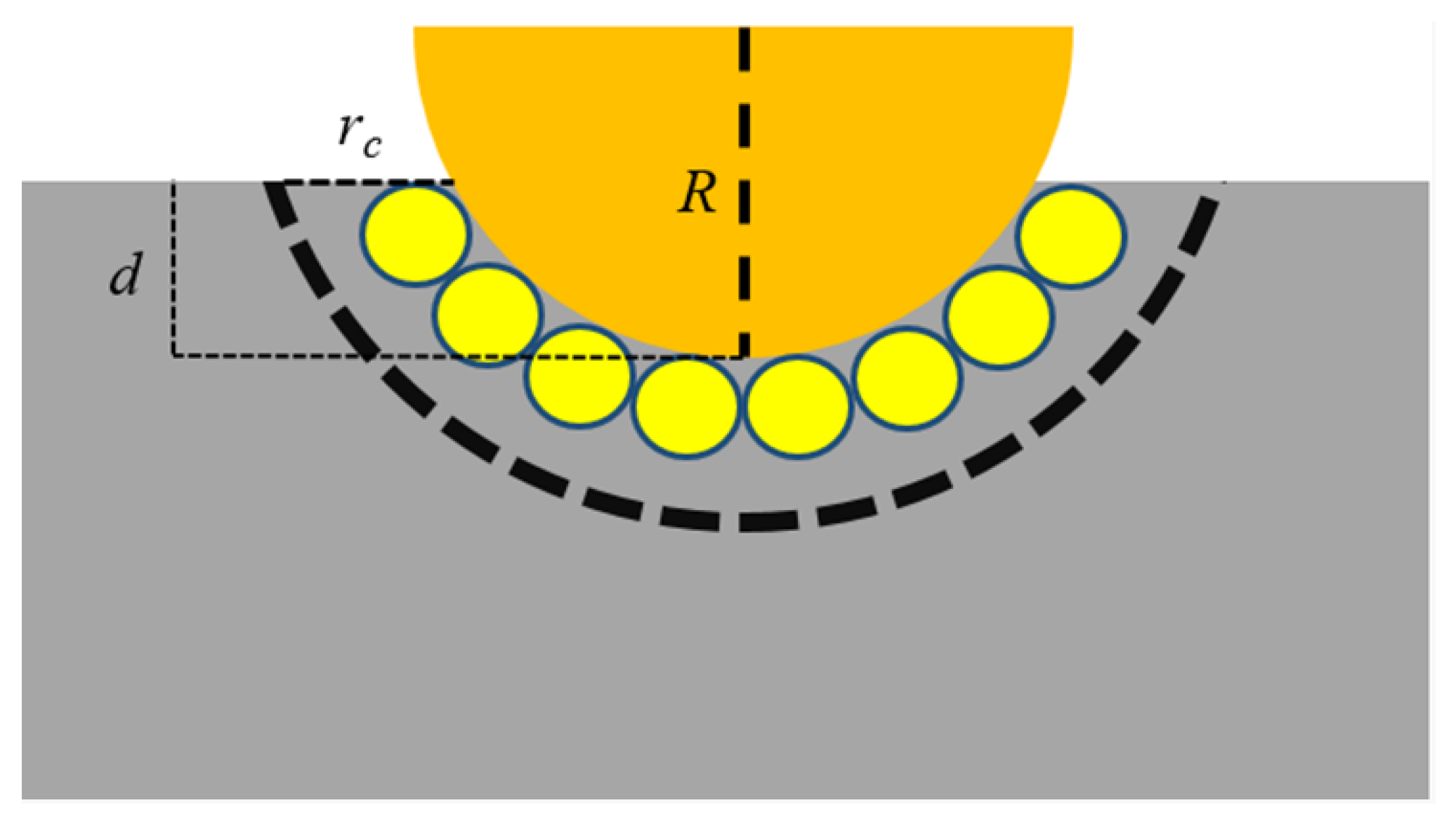
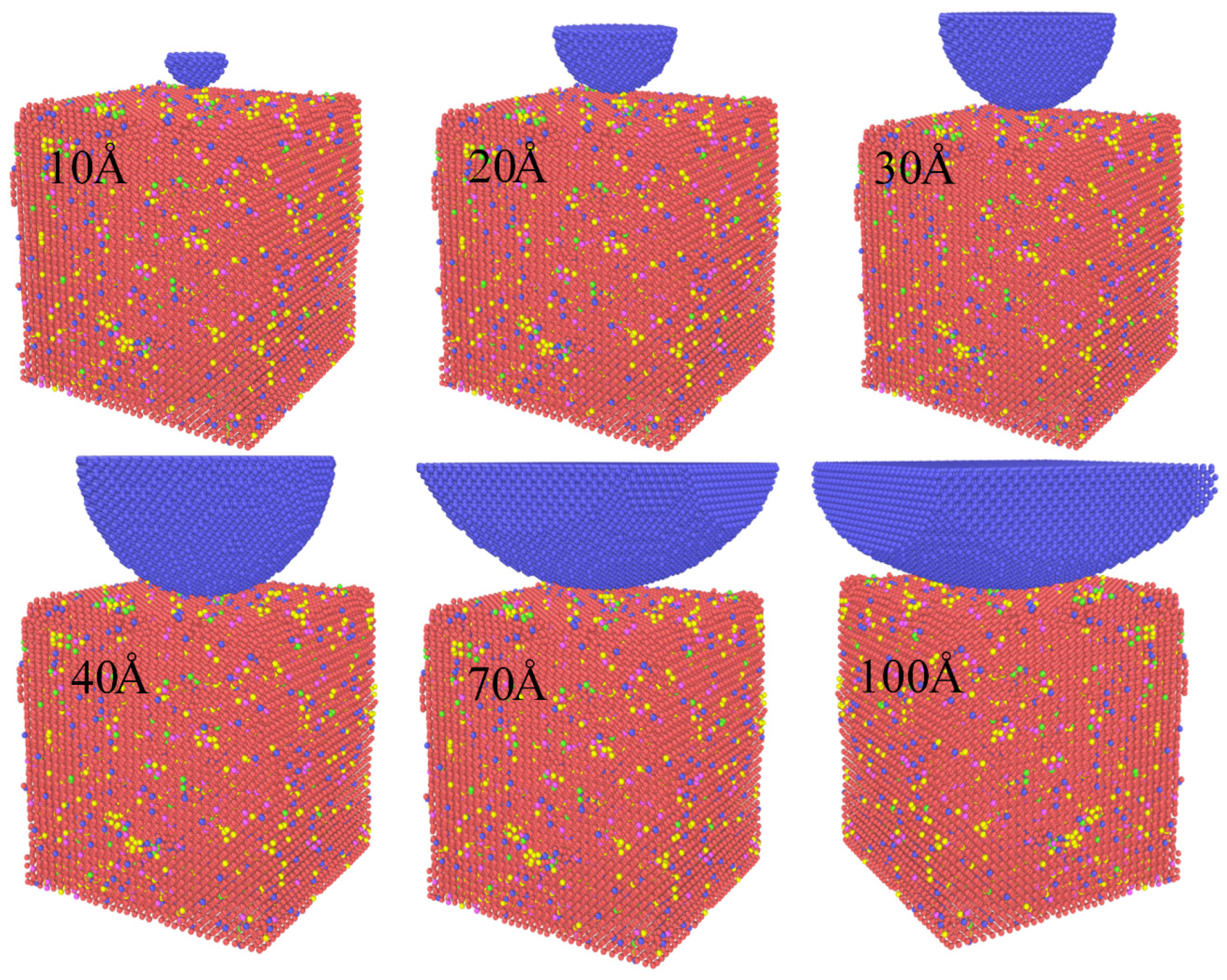

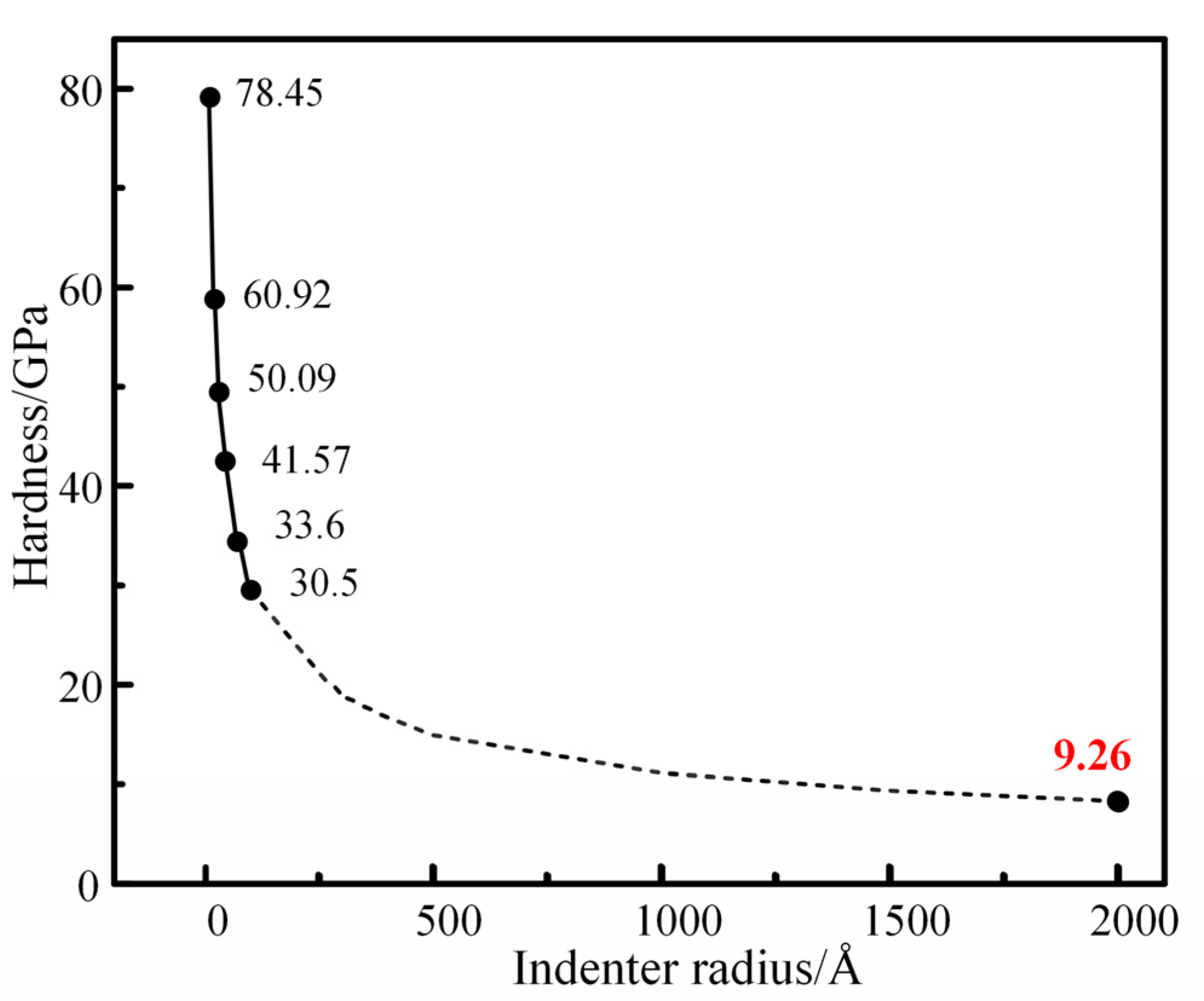
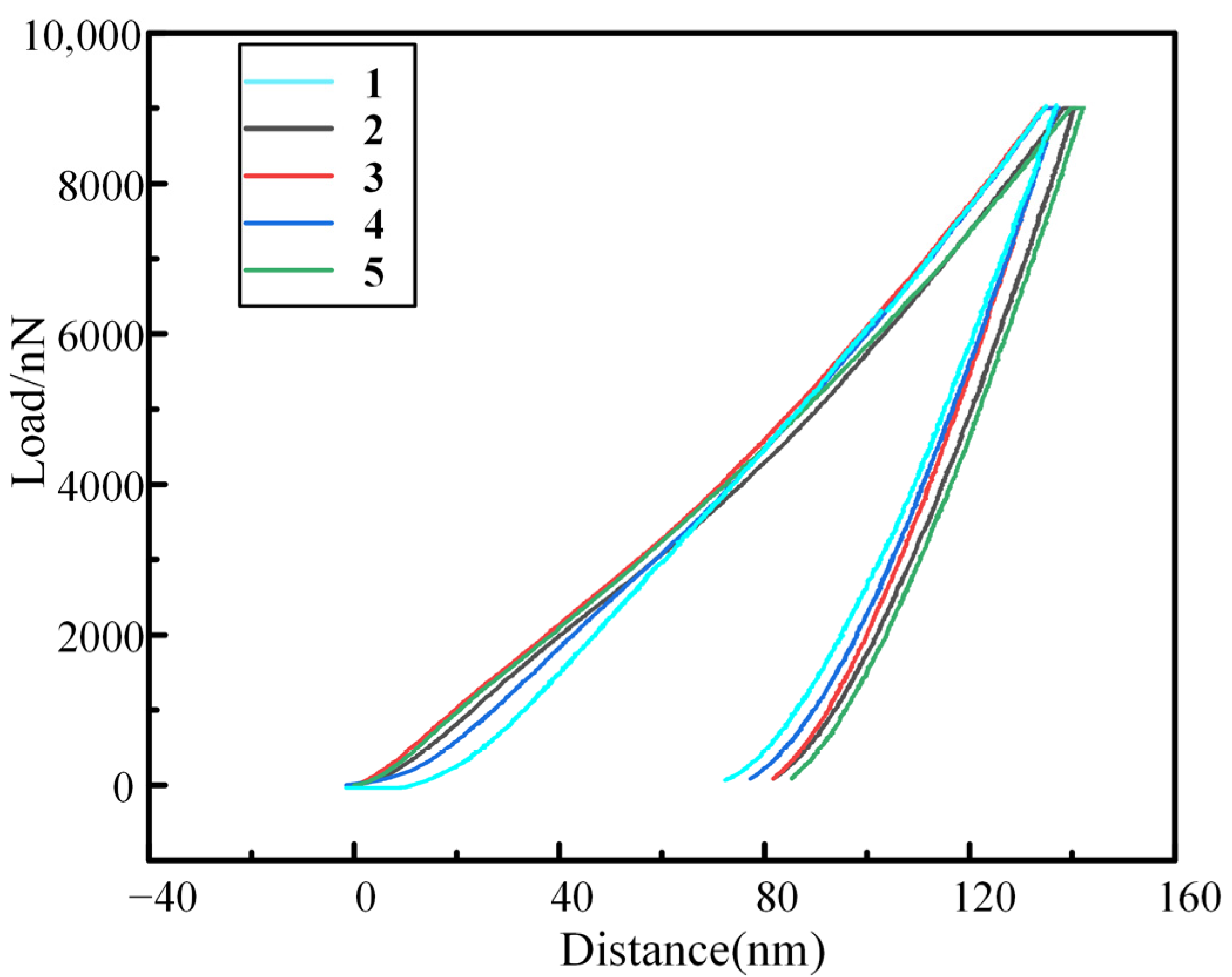
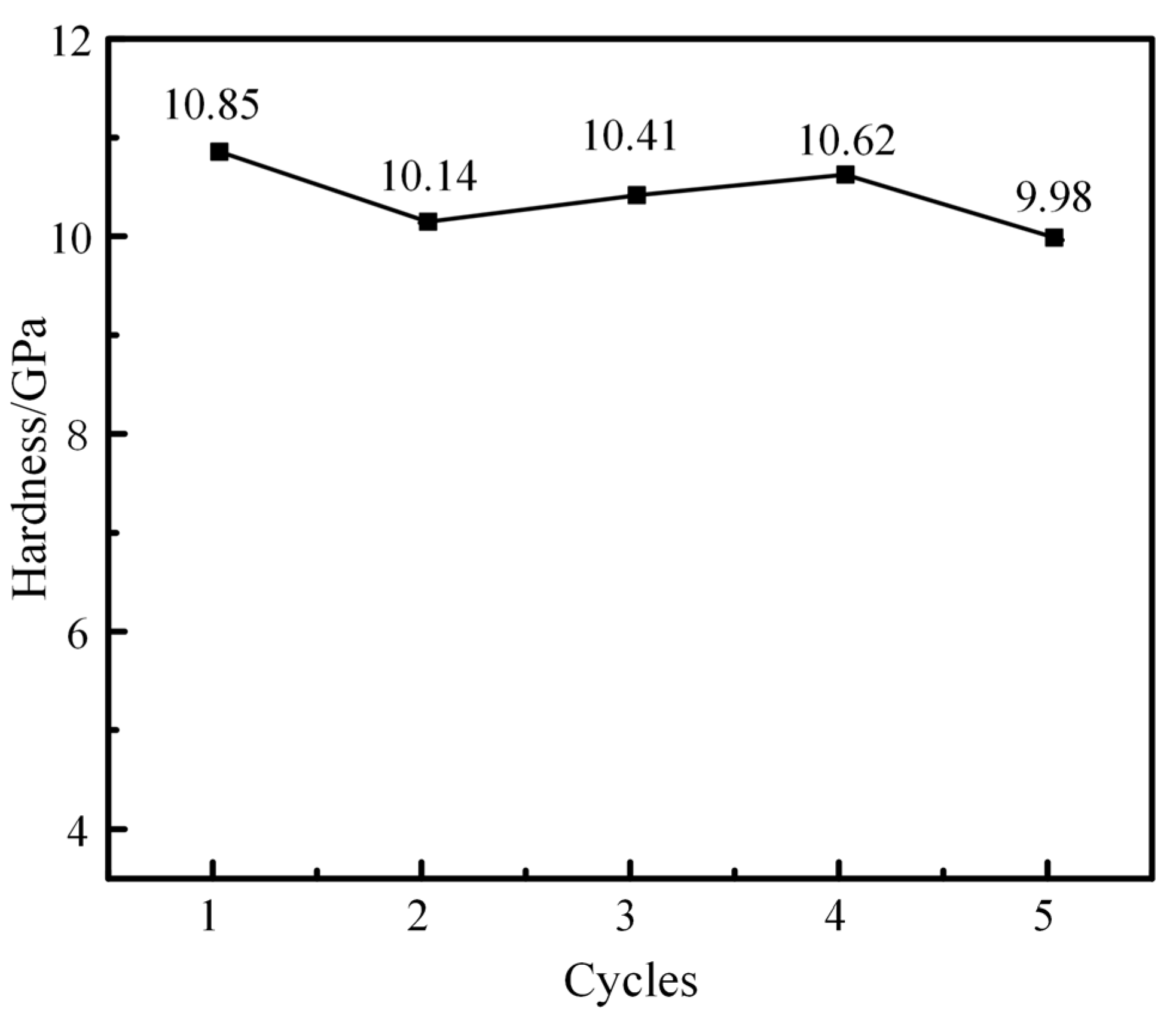
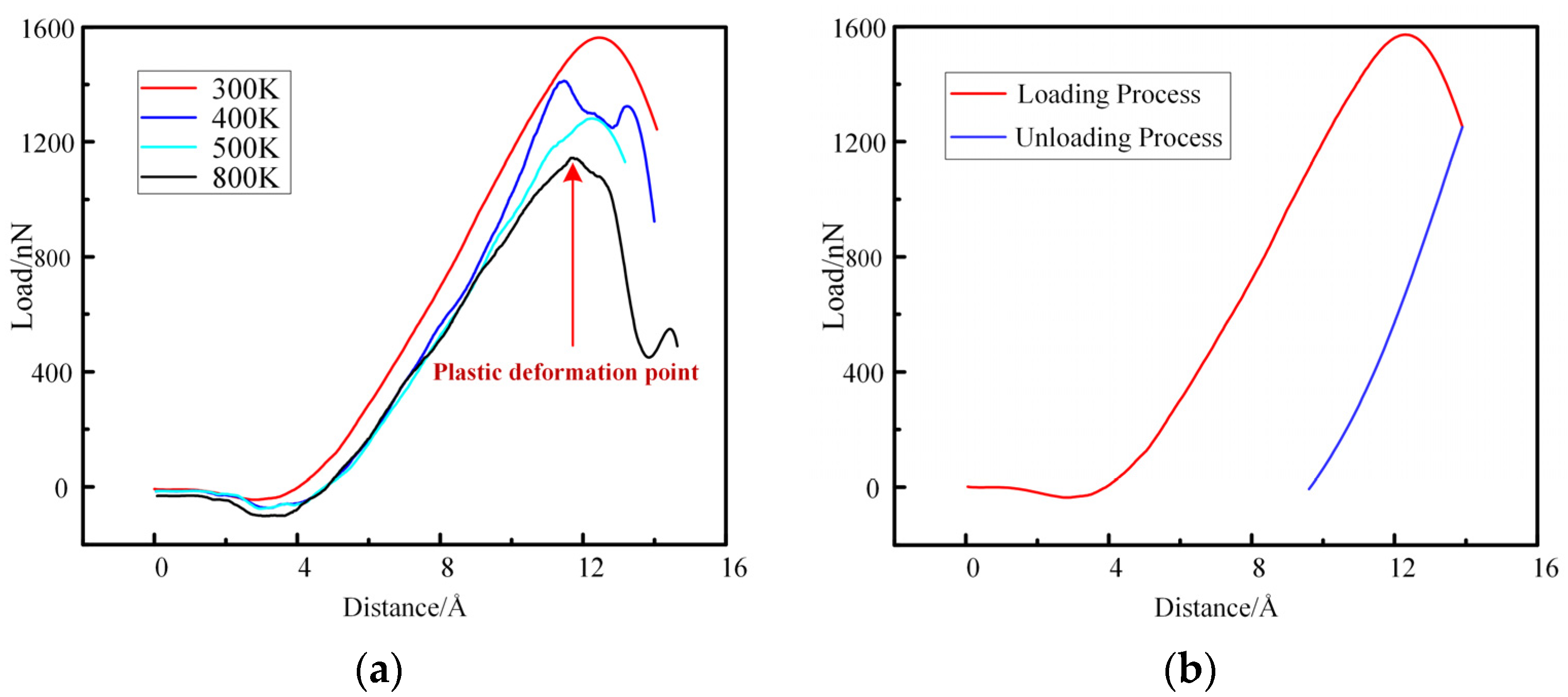
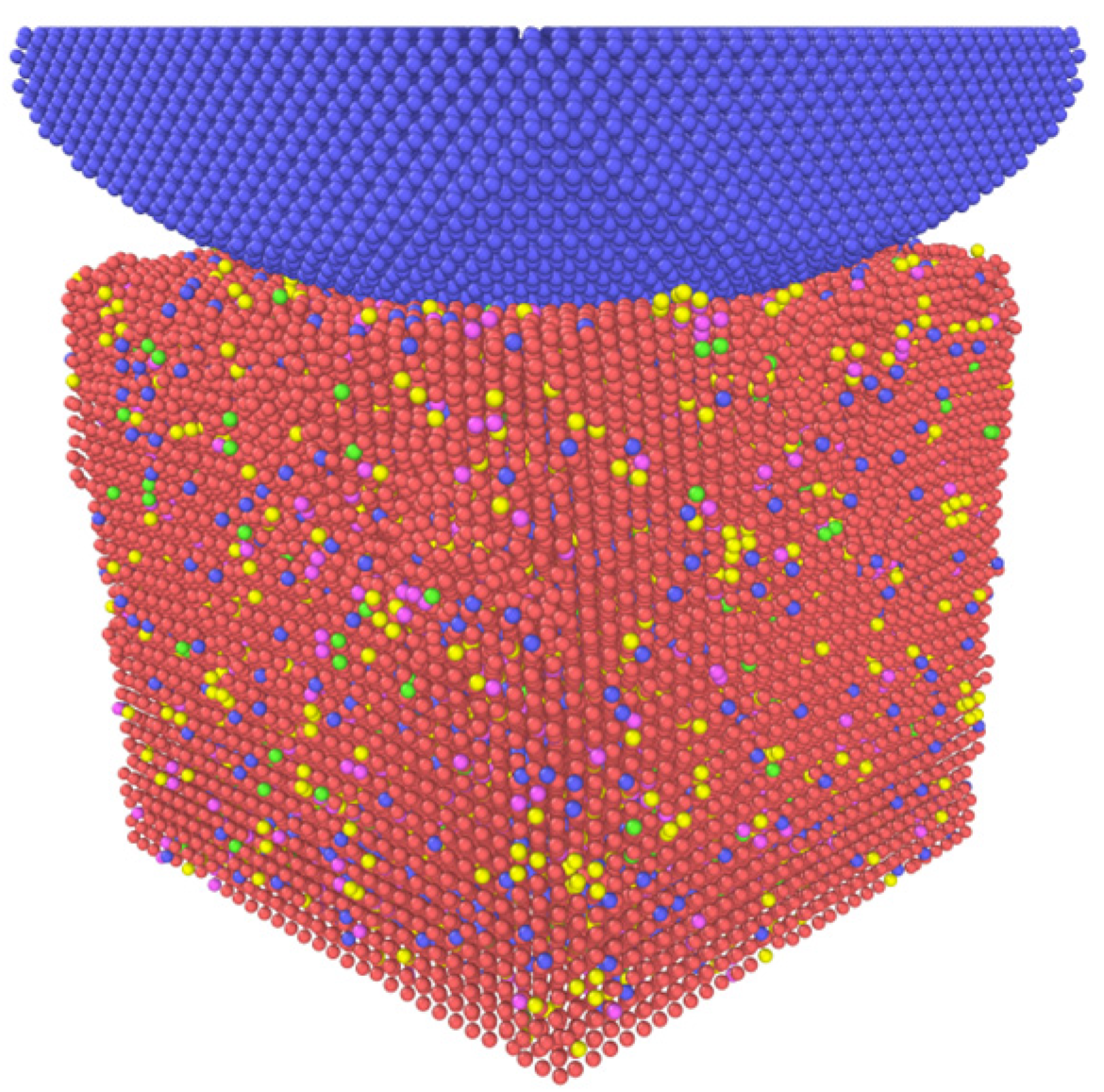
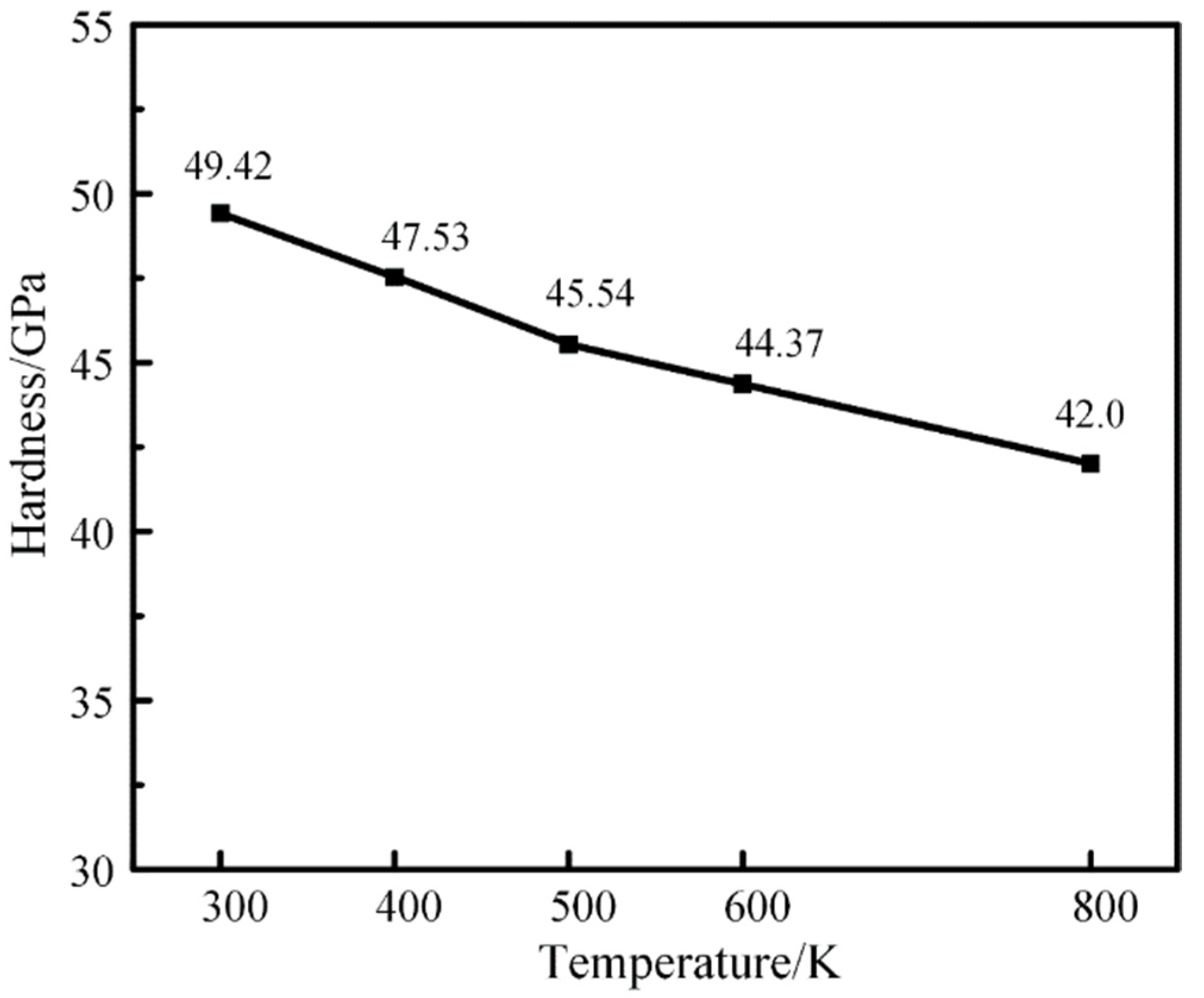
| Grade of Steel | C | Cr | Mo | V | Ni | S | P |
|---|---|---|---|---|---|---|---|
| M50 | 0.8–0.85 | 4–4.5 | 4–4.5 | 0.9–1.1 | ≤0.15 | ≤0.008 | ≤0.015 |
| Species | ε (eV) | σ (Å) |
|---|---|---|
| Cr-V | 6.718 × 10−4 | 2.747 |
| C-Cr | 1.721 × 10−3 | 3.062 |
| C-Mo | 3.325 × 10−3 | 3.0749 |
| C-V | 1.777 × 10−3 | 3.1159 |
Disclaimer/Publisher’s Note: The statements, opinions and data contained in all publications are solely those of the individual author(s) and contributor(s) and not of MDPI and/or the editor(s). MDPI and/or the editor(s) disclaim responsibility for any injury to people or property resulting from any ideas, methods, instructions or products referred to in the content. |
© 2023 by the authors. Licensee MDPI, Basel, Switzerland. This article is an open access article distributed under the terms and conditions of the Creative Commons Attribution (CC BY) license (https://creativecommons.org/licenses/by/4.0/).
Share and Cite
Hu, X.; Yang, L.; Wei, X.; Wang, H.; Fu, G. Molecular Dynamics Simulation on Nanoindentation of M50 Bearing Steel. Materials 2023, 16, 2386. https://doi.org/10.3390/ma16062386
Hu X, Yang L, Wei X, Wang H, Fu G. Molecular Dynamics Simulation on Nanoindentation of M50 Bearing Steel. Materials. 2023; 16(6):2386. https://doi.org/10.3390/ma16062386
Chicago/Turabian StyleHu, Xuyang, Lei Yang, Xunkai Wei, Hao Wang, and Guoru Fu. 2023. "Molecular Dynamics Simulation on Nanoindentation of M50 Bearing Steel" Materials 16, no. 6: 2386. https://doi.org/10.3390/ma16062386





